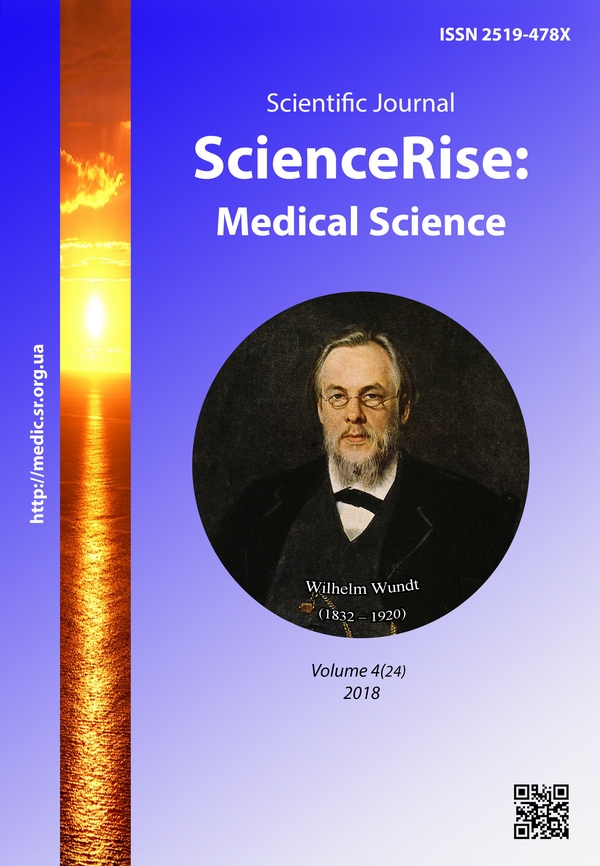Ophthalmologic and pediatric predictors of the development of the acquired myopya in children
DOI:
https://doi.org/10.15587/2519-4798.2018.132557Keywords:
development of myopia, risk factors, children, connective tissue dysplasiaAbstract
The aim of the research - to conduct an analysis of ophthalmologic and pediatric factors contributing to the development of acquired myopia in children.
Methods of research: We examined 52 children (104 eyes) aged from 6 to 13 years without ophthalmic pathology. Visual acuity in all children was 1.0. The observation period was 12–24 months. A dynamic monitoring of this group of children showed that myopia subsequently developed in 26 children (52 eyes) of the main group, and in 26 children (52 eyes) myopia was not observed (control group). We performed an ophthalmologic examination and determination of the presence of phenotypic signs of the syndrome of connective tissue dysplasia and the degree of its severity.
Results: The conducted factor analysis revealed 3 main factors that were designated as an «anatomical-constitutional» factor (48.9% of the total dispersion), «hereditary» (7.6% of the total dispersion) and «morphometric» (7.1% of the total dispersion). When using ROC-analysis, optimal distribution points of the indicators that influence the development of acquired myopia were determined. The сut-off value of the corneal refractive index was ≤41.5 dpm, the axial length of the eye ≥23.9 mm, the radius of the cornea ≥7.88 mm, the corneal diameter ≥11.85 mm, the thickness of the layer of peripapillary nerve fibers ≤95.0 μm, reserve of relative accommodation ≤ 1.5 dpi, degree of dysplasia ≥2.0.
The statistically significant correlation relations between the degree of connective tissue dysplasia and the anatomical-optical parameters of the visual analyzer were revealed: refractive corneal force (r=-0.68, p <0.05), axial eye length (r=0.58, p <0 , 05), radius of the cornea (r=0.71, p <0.05), corneal diameter (r=0.77, p <0.05), thickness of the layer of the peripapillary nerve fibers (r=-0.42, p <0,05) and the reserve of relative accommodation (r=-0,79, p <0,05). The correlation between the myopia heredity and the degree of dysplasia was (r=0.37, p <0.05). Thus, the risk of acquired myopia is higher in children with syndrome of connective tissue dysplasia, which emphasizes the importance and necessity of a multidisciplinary approach in the study of children with this pathology
References
- Vitovska, О. P., Savina, O. M. (2015). Struktura ta chastota khvorob oka ta prydatkovoho apparatu u ditei v Ukraini [Structure and frequency of eye diseases and adnexal apparatus in children in Ukraine]. Medychni perspektyvy, 3, 133–138.
- Iomdina, E. N., Taruta, E. P. (2014) Sovremennyie napravleniya fundamentalnyih issledovaniy patogeneza progressiruyuschey miopii [Modern directions of fundamental studies of the pathogenesis of progressive myopia]. Vestnik RAMN, 3-4, 44–49.
- Pizzarello, L., Abiose, A., Ffytche, T., Duerksen, R., Thulasiraj, R., Taylor, H. et. al. (2004). VISION 2020: The Right to Sight: a global initiative to eliminate avoidable blindness. Archives of Ophthalmology, 122 (4), 615–620. doi: 10.1001/archopht.122.4.615
- Ahaev, F. B., Shukiurova, A. R. (2010). Sravnitelnaya otsenka faktorov I stepeni riska miopii u detey [Comparative assessment of the factors and degree of risk of myopia in children]. Mezhdunarodnyiy meditsinskiy zhurnal, 16 (3), 41–44.
- He, M., Xiang, F., Zeng, Y., Mai, J., Chen, Q., Zhang, J. (2015). Effect of Time Spent Outdoors at School on the Development of Myopia Among Children in China. JAMA, 314 (11), 1142–1148. doi: 10.1001/jama.2015.10803
- Zeinalov, V. Z. (2011). Klinicheskoe znachenie vyiyavleniya vzaimosvyazi mezhdu anatomo-opticheskimi parametrami glaz i iz vliyanie na formu glaznogo yabloka pri vseh vidah klinicheskoy refraktsii [The clinical significance of revealing the relationship between the anatomical and optic parameters of the eyes and the effect on the shape of the eyeball for all types of clinical refraction]. Oftalmologiya, 3, 37–42.
- Kadurina, T. I., Horbunova, V. N. (Eds.) (2009). Displaziya soedinitelnoy tkani [Connective tissue dysplasia]. Saint Petersburg: ELBI, 714.
- Budnik, T. V. (2014). Rezultaty sopostavleniya fenotipicheskih i klinicheskih priznakov nedifferentsirovannoy displazii soedinitelnoy tkani, mikroelementnoy obespechennosti i oftalmologicheskih dannyih u detey s progressiruyuschey miopiey [The results of comparison of phenotypic and clinical ignsofun differentiated connective tissue dysplasia, microelement supply and ophthalmological data in children with progressive myopia]. Perinatologiya i pediаtriya, 2, 41–45.
- Seleznev, A. V., Nasu, H. (2012). Dinamika miopicheskoy bolezni u lits s sindromom displazii soedinitelnoy tkani [Dynamics of myopic disease in individuals with connective tissue dysplasia syndrome]. Oftalmohirurgiya, 4, 73–75.
- Tihomirov, N. P., Tihomirova, T. M., Ushmaev, O. S. (2011). Metody ekonometriki i mnogomernogo statisticheskogo analiza [Methods of Econometrics and Multidimensional Statistical Analysis]. Moscow: Ekonomika, 647.
- Tsybulska, T. Ie., Zavhorodnia, N. H., Pashkova, O. Ie. (2018). Prohnozuvannia ryzyku prohresuvannia nabutoi miopii u ditei shkilnoho viku [Prediction of the risk of progression of acquired myopia in school-age children]. Oftalmolohichnyi zhurnal, 1, 7–12.
Downloads
Published
How to Cite
Issue
Section
License
Copyright (c) 2018 Tamila Tsybulska

This work is licensed under a Creative Commons Attribution 4.0 International License.
Our journal abides by the Creative Commons CC BY copyright rights and permissions for open access journals.
Authors, who are published in this journal, agree to the following conditions:
1. The authors reserve the right to authorship of the work and pass the first publication right of this work to the journal under the terms of a Creative Commons CC BY, which allows others to freely distribute the published research with the obligatory reference to the authors of the original work and the first publication of the work in this journal.
2. The authors have the right to conclude separate supplement agreements that relate to non-exclusive work distribution in the form in which it has been published by the journal (for example, to upload the work to the online storage of the journal or publish it as part of a monograph), provided that the reference to the first publication of the work in this journal is included.









